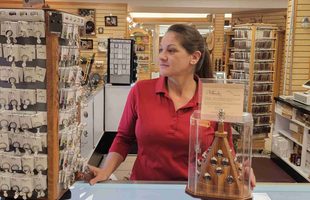During the uncertain times of the COVID-19 pandemic, owners and managers of candy shops have had to shift gears to ensure that customers could still get some joy by indulging in a sweet treat.
Of the utmost importance is implementing additional measures to ensure sanitary operations. As of late March, due to government restrictions Bethanie Greenaway, general manager, Harvard General Store, Harvard, Mass., could no longer allow customers in her store. “We sell items via our online store and pack them for designated pick-up times,” she said.
 Susan Bowie, customer service specialist, of Cocoa Dolce Chocolates, photographed at a candy counter. E-blasts are one way the company communicates with customers.
Susan Bowie, customer service specialist, of Cocoa Dolce Chocolates, photographed at a candy counter. E-blasts are one way the company communicates with customers. Only a few employees work to fill orders and keep inventory of baked goods and some prepared goods. “Those of us who work practice strict social distancing to ensure that everyone stays healthy,” Greenaway said. “We work in staggered shifts to avoid interacting with each other. Employees thoroughly wash their hands and sanitize them upon entering the building. They use our standard operating procedures when preparing food, following our existing food safety practices.” Beyond that, the shop uses the utmost caution when setting out items for pick up and regularly sanitizes the pick-up space, door handles phones, key pads and so forth.
Denise Lindbo, owner of a 4,000-square-foot shop called Gourmet Chef in Minot, N.D., has hand dispensing stands right outside the front door and on the counters. Only one door is kept open to the public. “We ask people to sanitize before coming in and after money transactions,” she said. Wiping all surfaces, door handles, phones, keyboards and so forth is also paramount.
As a business that always prided itself on cleanliness, Angie Gonzalez, who works in purchasing and social media at Cocoa Dolce Chocolates, Wichita, Kan., said during the outbreak the production facility has had a heightened sense of cleaning and sanitizing. Three retail locations, which are approximately 1,200 square feet each, have Clorox wipes at registers to wipe down in between customers. Extra cleaning duties and multiple cleaning times have been added.
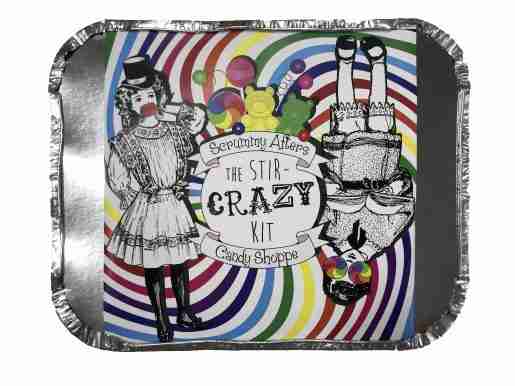 Merchandise boxes offering a little humor too from Scrummy After’s Candy Shoppe in Hallowell, Maine. The Stir Crazy Kits contain chocolates, candies and activity sheets.
Merchandise boxes offering a little humor too from Scrummy After’s Candy Shoppe in Hallowell, Maine. The Stir Crazy Kits contain chocolates, candies and activity sheets.Best-Sellers
Prior to its new system of online ordering, Harvard General Store’s baked goods and prepared foods were always best-sellers. “Customers enjoy our scratch-made items; it’s important that we still give them an opportunity to get our comfort food items,” Greenaway said. “We sell frozen scones and cookie dough by the half dozen with baking instructions, quarts of some our most popular soups, and our famous brownies, blondies, raspberry and pecan bars because they can be frozen or refrigerated to extend their life.”
During the pandemic, Lindbo observed that more commodity type items such as soup mixes, bread mixes, coffees and teas made from local companies remained good sellers.
Hilary Davis, co-owner, Scrummy Afters Candy Shoppe, Hallowell, Maine, said her current best-seller is a hand-woven chocolate spring basket. “They appeal to customers because they look like real baskets although they’re entirely edible,” she said. “Customers appreciate the attention to detail and uniqueness of each basket.”
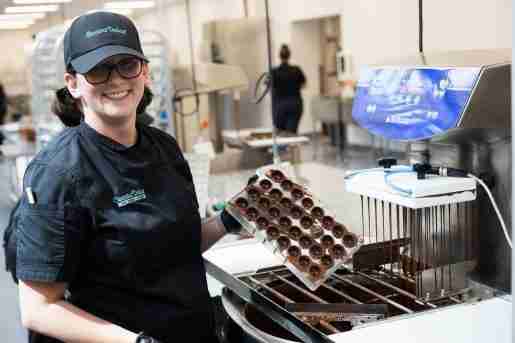 Lisa Mickey, professional chocolatier with Cocoa Dolce Chocolates, Wichita, Kan. Custom-built boxes are best-sellers for the store.
Lisa Mickey, professional chocolatier with Cocoa Dolce Chocolates, Wichita, Kan. Custom-built boxes are best-sellers for the store.Gift Box and Basket Sales
In the gift box and basket category, custom-built boxes tend to be best-sellers for Cocoa Dolce Chocolates. “Customers have the option to purchase a standard assortment full of our chosen favorites and best-sellers or they have the option to create their own assortment,” Gonzalez said. “By creating their own assortment, they are guaranteed to receive their favorites and choose based on their preferences.”
Gift box sales remain steady during the pandemic, and quantities ordered have increased. “I think people stocked up to be able to enjoy them from their own homes once stay-at-home orders were in place,” Gonzalez said. “We are also seeing a spike in online sales. The idea that people can shop from home and have items delivered directly to them seems appealing.”
Davis developed “Stir-Crazy”’ gift boxes, which contain chocolates, candies and activity sheets that appeal to both adults and kids. “We will launch them on our online site shortly, and expect them to be popular,” she said.
Harvard General Store offers personalized gift baskets with local gift items, honey, maple syrup, apparel, tea, coffee, beer, wine and liquor. Customers can order the baskets as well as gifts cards online.
Greenaway hoped to begin offering take out once the initial two-week shelter-in-place advisory was over.
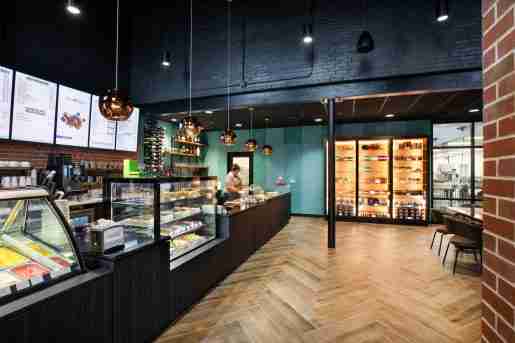 An interior of a downtown retail location for Cocoa Dolce Chocolates. The store’s management takes pleasure in providing treats to the public during the pandemic.
An interior of a downtown retail location for Cocoa Dolce Chocolates. The store’s management takes pleasure in providing treats to the public during the pandemic.Operating During a Pandemic
It’s important for candy shop owners and managers to be patient and flexible during uncertain times. “We were so lucky to have talented staff that is flexible and a marketing manager who has experience with e-commerce,” Greenaway said. “We owe our ability to continue to serve the community and bring in revenue to her setting up an online store and uploading inventory in record time.”
Lindbo increased the shop’s online presence. “Doing online sales with discounted items has been a big hit,” she said. “People want to support us, and this is a good way for them to help out. We make in-town deliveries and also ship out. Keeping our sites upbeat and positive makes a huge difference.”
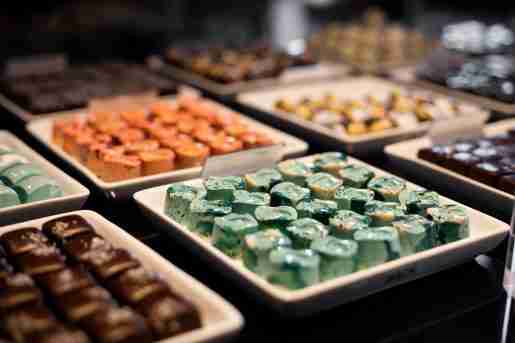 Candy in a sales case at Cocoa Dolce Chocolates. Bigger quantities of product are being ordered during the pandemic.
Candy in a sales case at Cocoa Dolce Chocolates. Bigger quantities of product are being ordered during the pandemic. Gonzelaz took each news conference and health update to heart and adjusted her standards accordingly. “From heightened cleaning of our operations to limiting staff in all aspects of our business, we have tweaked our operations each day,” she said. “We appreciate that our community continues to choose us when they want to get out and splurge on something special. We hope with each sale, we provide a sweet escape during this time. We are happy to spread that joy, one piece at a time!”
When the trajectory of the virus was set in motion, Davis closed her 900-square-foot storefront to do her part for the community’s health. “Up until that point, we had only ever talked about offering online purchasing options,” she said. “We restructured our business from brick-and-mortar to a virtual experience.” She retrofitted an offsite commercial kitchen and storage area where chocolate products were made for additional space for packaging and shipping.
Davis has found that creativity often blooms in the most inhospitable and unexpected of conditions. “I have acknowledged that our business model has forever changed,” she said. “The bright side of survival mode is that you’re forced to reevaluate the areas of your business that have been dead weight— the parts that you’ve been clinging to for emotional reasons but ultimately hold you back. This could be a rebirth for all of us.”
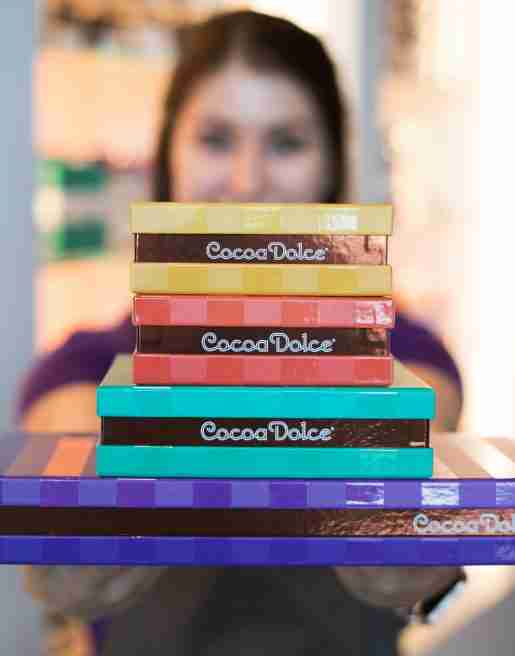 Kristin Khosravipour, retail store manager, Cocoa Dolce Chocolates, holding boxes of candy. Both standard assortments and built-by-the-customer candy boxes are available from the company.
Kristin Khosravipour, retail store manager, Cocoa Dolce Chocolates, holding boxes of candy. Both standard assortments and built-by-the-customer candy boxes are available from the company.Keeping Customers Informed
During uncertain times, it’s important that customers can easily get the latest information on how stores are operating. Gonzalez has a few avenues of communication to choose from. “We have a great following on our social media outlets including Facebook, Instagram and Twitter,” she said. “We’re able to communicate via e-blasts to our customer list as announcements on our website. We have in-store signage at each retail location.”
Davis seems to get the most traction on Facebook, so she communicates through that venue. She also has a growing database of emails through her point of sale (Square) which she uses for direct mailers.
Greenaway keeps customers updated about changes via the store’s website, social media (Instagram and Facebook) and its email list.
Lindbo gets the word out via Facebook, Instagram, radio and e-newsletters. Word of mouth from her customer base to others has also worked well.



